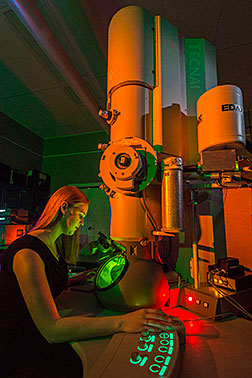- Number 415 |
- June 9, 2014
Katie Jungjohann feels lucky, but perhaps there’s more to it

Katie Jungjohann at work on the Center for
Integrated Nanotechnology’s transmission
electron microscope. CINT is a user facility
operated by Sandia and Los Alamos national
laboratories for the Department of Energy’s
Office of Science. (Photo by Randy Montoya)
Katie Jungjohann received her doctorate in materials science little more than three years after receiving a bachelor’s degree in chemistry — an enviably short time to ascend the academic ladder.
After only a year as a postdoctoral appointee at Brookhaven National Laboratory, she came to DOE's Sandia National Laboratories in March 2013 as the staff scientist responsible for the Center for Integrated Nanotechnology’s (CINT) transmission electron microscope (TEM) laboratory. CINT is a national user facility operated by Sandia and Los Alamos national laboratories for Department of Energy's Office of Science to develop scientific principles that govern the design, performance and integration of nanoscale materials.
In addition to her own research, Jungjohann collaborates on some of the most important projects that come from users outside CINT, maintains the ultra-modern instrument and trains doctoral and postdoctoral students in its use.
She has progressed rapidly in her career — she is already a senior member of Sandia’s technical staff with 11 technical publications to her credit — and attributes her success in part to growing up in a family with high academic expectations.
'Awful grammar' skills, but gifted in science
She didn’t follow her family’s primary focus, medicine, because she failed to meet her own expectations on the Medical College Admissions Test (MCAT) — the prerequisite exam for medical school. Her self-assessment was that English skills weren’t her strength: “awful grammar, and I can’t spell for the life of me.” Luckily, her future was already shaped in part by her work under three very good high school teachers in physics, math and chemistry.
She received her doctorate from the University of California, Davis so rapidly because her adviser left for a job at Pacific Northwest National Laboratory after Jungjohann helped advance a new TEM technique.
“The idea [of imaging liquids in a TEM] had been around since the 1930s but it proved a hard task to prepare a sample that could survive the experience,” Jungjohann said. “Researchers tried to contain the liquid by encasing the sample between little windows made of carbon films, but to survive electron beam exposure, the films had to be so thick that the imaging radiation could barely pass through them.”
In 2003, a research article suggested silicon-nitride windows might be made thin enough to transmit electrons, yet mechanically robust enough not to break inside the microscope.
In 2008, a company commercialized this instrumentation with a better device to hold the ultrathin windows. “My adviser was collaborating with the company,” Jungjohann said. “They gave us their product for a reduced fee and we gave feedback on how it operated. I was fortunate to be one of the first students working on this holder for liquid-cell TEM. I spent my time in grad school learning how to perfect the technique.”
‘Luck’ and hard work
In keeping with the humorously insightful aphorism, it seemed that the harder Jungjohann worked, the luckier she got.
She was invited to test her samples on a dynamic TEM (DTEM) at Lawrence Livermore National Laboratory, at the time the only DTEM in the world. This instrument is capable of achieving 15-nanosecond images at 10-nanometer resolution.
“Looking at transient states in irreversible processes, you need high temporal resolution,” Jungjohann said.
One reason the DTEM could image samples so frequently was because it used a reduced electron beam current that damaged samples less. “I’d love to have one of those machines at CINT,” she said.
But she’s happy at Sandia using spectroscopy to locate specific energy losses on nanomaterials suspended in liquid. The losses reveal chemical composition as well as information about electronic structures.
Shooting the messenger
Helping in the quest to improve battery efficiency, she uses the TEM to study how lithium ions enter an electrode. “Batteries transport lithium ions from cathodes to where they insert themselves in the atomic lattices of the anode, a process called intercalation. For optimal electrical storage capacity, manufacturers would like to engineer this interface to improve ion transport and reduce the products causing degradation. Our characterizations are used as feedback to people doing computer modeling, or by the synthesis people to re-engineer new materials.
“Also, our users tell me how they synthesized a material. I tell them my results, and then suggest varying the structure to see if it works better. Some people,” she said, smiling slightly, “get upset because they think the TEM is wrong.”
She loves understanding the fundamental properties of materials and feels fortunate to be in the right place to do it. “I like TEM work at CINT because we’re not investigating the same structure every day. We use our tools to help other people answer their materials questions, so there’s something new to be learned all the time.
“We have limited resources, but we do pick the most impactful science. We’re trying to build fundamental structures and methods to test them more efficiently so we can excel in other areas of research.”
Asked about her hobbies, the former national backstroke swimming competitor deflects the question. “It takes time to get grounded. I spend a lot of hours here — Sundays less than Mondays,” she said wryly.
Fortunately, her self-employed husband — the proverbial childhood sweetheart she met in Oregon — can keep pace with her rapid career moves because he makes indoor climbing holds to sell online. His craftsman job dovetails with the upcoming need for an at-home parent for their expected baby. Several Sandia TEM experts are expected to seamlessly manage the lab during Jungjohann’s absence.
“I stay very busy, and I’m very happy to be here,” she said. “I guess I’m just lucky.”Submitted by DOE's Sandia National Laboratories
